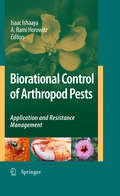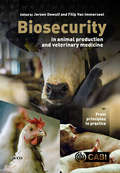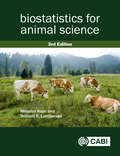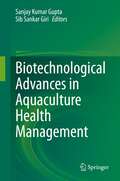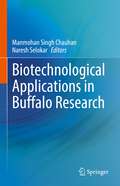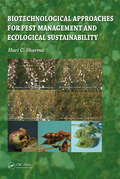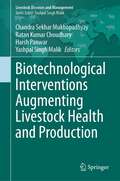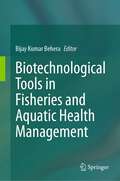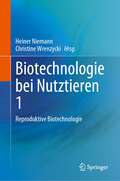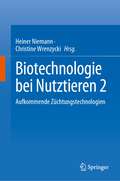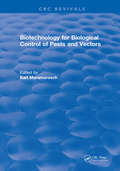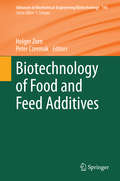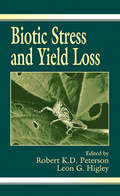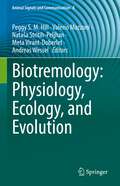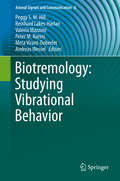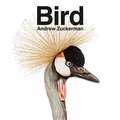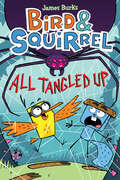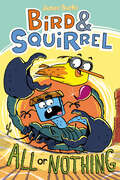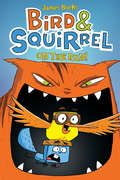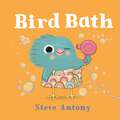- Table View
- List View
Biorational Control of Arthropod Pests: Application and Resistance Management
by Isaac Ishaaya A. Rami HorowitzThis book deals with various approaches for arthropod pest control. One approach is based on disrupting the activity of specific biochemical sites such as neuropeptides, ecdysone and juvenile hormones or tyramine, octopamine and GABA receptors. Another approach is the use of natural products obtained from tropical plants and other biological systems for pest control. Finally, the exploiting of genetically modified insects, plants and symbionts along with male/female call disturbance are important novel tools in crop protection. Countermeasures for resistance to biorational control agents using advanced biological and biochemical approaches are discussed.
Biosecurity for Livestock Diseases in Europe: Transmission, Risk Factors, and Modelling
by Jeroen Dewulf Dr Alistair Antonopoulos Evelien Biebaut Johannes CharlierBiosecurity practices can help prevent the introduction and spread of disease, promoting better animal health and welfare, human health, food safety, and the economic benefits of livestock production. Stemming from a joint initiative between the Biosecure project which brought together 17 partners across 12 European countries, and DISCONTOOLS, the research gap database in animal health, this book provides valuable background information which can help to better understand and prioritize biosecurity measures. Driven by an evidence-based and cost-effective approach to biosecurity, it is divided into two sections covering endemic diseases typically present within most countries, and epidemic diseases with the potential for large scale outbreaks. Through a series of disease entries, it: - introduces the diseases of most relevance for the European context; - reviews our current understanding of biosecurity throughout the livestock production chain, and across the principal terrestrial animal species farmed within Europe: poultry, swine, cattle, and small ruminants; - covers the prevalence, risk factors, transmission routes, current control measures and biosecurity, and data for transmission modelling for each disease. By summarizing current knowledge on a range of diseases, this book forms both a useful resource for researchers and professionals in animal disease prevention, and a starting off point for identifying information gaps and requirements for future research.
Biosecurity in Animal Production and Veterinary Medicine: From principles to practice
by Jeroen Dewulf Filip Van ImmerseelGlobally, the way the animal production industry copes with infectious diseases is changing. The (excessive) use of antimicrobials is under debate and it is becoming standard practice to implement thorough biosecurity plans on farms to prevent the entry and spread of pathogenic micro-organisms. Not only in farm animal production, but also in facilities where companion animals are kept, including in veterinary practices and clinics, awareness of the beneficial implications of a good biosecurity plan has raised. The book Biosecurity in Animal Production and Veterinary Medicine is the first compilation of both fundamental aspects of biosecurity practices, and specific and practical information on the application of the biosecurity measures in different animal production and animal housing settings. The book starts with a general introductory chapter on the epidemiology of infectious diseases, followed by a chapter explaining the general principles of biosecurity. Specific topics of biosecurity, including rodent and insect control, cleaning and disinfection, hygiene and decontamination of feed, drinking water and air, and measuring the biosecurity status of farms, are detailed in dedicated chapters. Explanations on the relevance of the implementation of biosecurity plans in order to improve animal health and performance and reduce antimicrobial usage are described, and a chapter on ways to motivate farmers to implement a biosecurity plan has been included. Practical chapters deal with biosecurity in the poultry, pig and cattle industry, horse facilities, dog kennels, veterinary practices and clinics and laboratory animal facilities. The book is a practical guide that can be used by farm and animal facility managers, consultants, veterinarians, animal caretakers, and people with an interest in prevention of diseases in animals. Academics and students will benefit from the book because it contains all relevant information on animal biosecurity.
Biostatistics for Animal Science
by William Lamberson Miroslav KapsDesigned to cover techniques for analysis of data in the animal sciences, this popular textbook provides an overview of the basic principles of statistics enabling the subsequent applications to be carried out with familiarity and understanding. Each chapter begins by introducing a problem with practical questions, followed by a brief theoretical background. Most topics are followed up with numerical examples to illustrate the methods described using data-sets from animal sciences and related fields. The same examples are then solved using the SAS software package. Key features of this third edition: - Updated throughout, and covers a wealth of new distributions and new material on non-normal dependent variables - Improved clarity of text and examples - Includes both basic techniques and more complex procedures to provide an essential resource whatever your level - Contains exercises and many worked examples in SAS. Written primarily for students and researchers in animal sciences, the text is also useful for those studying agricultural, biological, and veterinary sciences.
Biostatistics for Animal Science, 3rd Edition
by Miroslav Kaps William R. LambersonDesigned to cover techniques for analysis of data in the animal sciences, this popular textbook provides an overview of the basic principles of statistics enabling the subsequent applications to be carried out with familiarity and understanding. Each chapter begins by introducing a problem with practical questions, followed by a brief theoretical background. Most topics are followed up with numerical examples to illustrate the methods described using data-sets from animal sciences and related fields. The same examples are then solved using the SAS software package. Key features of this third edition: - Updated throughout, and covers a wealth of new distributions and new material on non-normal dependent variables - Improved clarity of text and examples - Includes both basic techniques and more complex procedures to provide an essential resource whatever your level - Contains exercises and many worked examples in SAS. Written primarily for students and researchers in animal sciences, the text is also useful for those studying agricultural, biological, and veterinary sciences.
Biotechnological Advances in Aquaculture Health Management
by Sanjay Kumar Gupta Sib Sankar GiriThis book is an inclusive coverage of advances in aquaculture health management. It offers latest updates as well as explains the novel concepts and issues related to aquatic animal health management. To support the understanding of the concepts, there is extensive use of illustrations. Chapters emphasize on the state of art techniques and hold great promise for the sustainable development of aquaculture. This book is of interest to teachers, researchers, aquatic biologists, capacity builders and policymakers. Also the book serves as additional reading material for undergraduate and graduate students of aquatic sciences, marine sciences, biotechnology, ecology, and environmental sciences. National and international aquatic scientists, policy makers will also find this to be a useful read.
Biotechnological Applications in Buffalo Research
by Manmohan Singh Chauhan Naresh SelokarThis book comprehensively reviews the advancements in biotechnological applications for the enhanced production and conservations of buffalo (Bubalus bubalis). The book discusses developments in assisted reproduction to improve productivity and the produce novel products for applications to human health and nutrition. The initial chapters of the book discuss the global distribution and domestications of buffalo, and nutritive values of buffalo milk, while the subsequent sections examine the applications of the genome-wide association traits to identify potential genetic variants affecting important economic traits. It identifies predictive biomarkers for postpartum or peripartum diseased-state and presents potential protein biomarkers for the diagnosis of early pregnancy in buffalo. Lastly, it discusses recent scientific developments such as induced pluripotent stem cells, spermatogonial stem cells, somatic cell nuclear transfer, and buffalo as a model for human biomedical research. This book is a useful source to students, academicians, researchers, and policymakers who are involved in buffalo science and industry.
Biotechnological Approaches for Pest Management and Ecological Sustainability
by Hari C SharmaDue to increasing problems occurring from massive applications of pesticides, such as insect resistance to pesticides, the use of biotechnological tools to minimize losses from insect pests has become inevitable. Presenting alternative strategies for alleviating biotic stresses, Biotechnological Approaches for Pest Management and Ecological Sustain
Biotechnological Interventions Augmenting Livestock Health and Production (Livestock Diseases and Management)
by Chandra Sekhar Mukhopadhyay Ratan Kumar Choudhary Yashpal Singh Malik Harsh PanwarThis book comprehensively discusses the applications of molecular genetics, functional and structural genomics, and proteomics vis-a-vis bioinformatics, artificial intelligence, and robotics in livestock healthfulness and productivity. It reviews the biotechnological approaches in veterinary sciences for increasing productivity and resistance to disease. The book emphasizes the approaches based on artificial intelligence to analyze the data collected on animals, pathogens, and their environment. It underscores artificial intelligence applications in disease diagnosis, epidemiological studies, and detecting biological phenomena, including heat-detection, pregnancy, docility, and infections. Further, the book examines the genomics and proteomics approaches for understanding the gut microbiota and the role of pathogen-host interactions in animal health and disease. Lastly, it explores both pathogenic and non-pathogenic microbial transfer between humans, animals, and the environment across one health spectrum.
Biotechnological Tools in Fisheries and Aquatic Health Management
by Bijay Kumar BeheraThis edited book is focused on SDG 14: life below water. This book covers all aspects of fish biotechnology and health management. A detailed description is provided of CRISPR Cas9 technology application in the development of superior variety of fish with better growth, disease resistance, etc., accompanied by numerous helpful photographs and schematic diagrams. In addition, recent developments in nanotechnology and its application in fisheries production enhancement have been discussed. Further, topics includes, probiotics, immunostimulants, fish genetic markers, bioremediation, metagenomics, transgenerational immune priming, application of cell culture in fisheries and nano-biosensor application on fish disease diagnosis, pollution monitoring, etc. are provided in details. . The book is helpful for researchers, teachers, students, farmers, and entrepreneurs in utilizing the knowledge on recent advancements in different aspects of fish genetics and biotechnology for future research and aquaculture production enhancement.
Biotechnologie bei Nutztieren 1: Reproduktive Biotechnologie
by Heiner Niemann Christine WrenzyckiDieses zweibändige Lehrbuch bietet einen umfassenden Überblick über das weite Feld der Tierbiotechnologie mit besonderem Schwerpunkt auf der Reproduktion und Zucht von Nutztieren. Der Leser wird mit einer Vielzahl modernster Technologien und neuer genetischer Instrumente und deren Anwendungen in der Tierproduktion vertraut gemacht. Außerdem werden ethische und rechtliche Aspekte der Tierbiotechnologie erörtert und neue Trends und Entwicklungen auf diesem Gebiet kritisch bewertet. Das zweibändige Werk ist ein Muss für Doktoranden, fortgeschrittene Studenten und Forscher auf dem Gebiet der Veterinärmedizin, Genetik und Tierbiotechnologie.Dieser erste Band befasst sich hauptsächlich mit künstlicher Befruchtung, Embryotransfertechnologien bei verschiedenen Tierarten und der Kryokonservierung von Eizellen und Embryonen.
Biotechnologie bei Nutztieren 2: Aufkommende Züchtungstechnologien
by Heiner Niemann Christine WrenzyckiDieses zweibändige Lehrbuch bietet einen umfassenden Überblick über das weite Feld der Tierbiotechnologie mit besonderem Schwerpunkt auf der Reproduktion und Zucht von Nutztieren. Der Leser wird mit einer Vielzahl modernster Technologien und neuer genetischer Instrumente und deren Anwendungen in der Tierproduktion vertraut gemacht. Außerdem werden ethische und rechtliche Aspekte der Tierbiotechnologie erörtert und neue Trends und Entwicklungen auf diesem Gebiet kritisch bewertet. Das zweibändige Werk ist ein Muss für Doktoranden, fortgeschrittene Studenten und Forscher auf dem Gebiet der Veterinärmedizin, Genetik und Tierbiotechnologie.Dieser zweite Band ist den genetischen Werkzeugen der Tierbiotechnologie gewidmet, wie dem somatischen Klonen, transgenen Technologien und der Anwendung von Stammzellen in der Tierzucht. Auch ethische und rechtliche Aspekte werden erörtert.
Biotechnology for Biological Control of Pests and Vectors
by Karl MaramoroschThis book describes new strategies being used to combat disease agents and invertebrate pests. Outstanding experts from the United States, Belgium, China, Guatemala, Japan, Philippines, Singapore, and Thailand have contributed chapters that cover the latest achievements in genetic engineering, emphasizing the microbial and viral biological control agents that can provide environmentally safe, economical control systems. Topics discussed include genetic engineering of Bacillus thuringiensis and B. sphaericus, the development of insect resistance to microbial biocontrol agents, engineering of baculoviruses and nematodes, bioengineering of plants, plant transformation by particle bombardment, fusion of cultured insect cells, new immunodiagnostic assays and control measures against parasitic human diseases, and genetically engineered microbial agents for malaria control. The book also presents improved mass production procedures of microbial and viral biocontrol agents, as well as regulatory and environmental aspects of genetically engineered biocontrol agents. Biotechnology for Biological Control of Pests and Vectors will provide a valuable reference for researchers and students of biological control, microbiology, virology, and molecular biology.
Biotechnology of Food and Feed Additives (Advances in Biochemical Engineering/Biotechnology #143)
by Holger Zorn Peter CzermakThis book review series presents current trends in modern biotechnology. The aim is to cover all aspects of this interdisciplinary technology where knowledge, methods and expertise are required from chemistry, biochemistry, microbiology, genetics, chemical engineering and computer science. Volumes are organized topically and provide a comprehensive discussion of developments in the respective field over the past 3-5 years. The series also discusses new discoveries and applications. Special volumes are dedicated to selected topics which focus on new biotechnological products and new processes for their synthesis and purification. In general, special volumes are edited by well-known guest editors. The series editor and publisher will however always be pleased to receive suggestions and supplementary information. Manuscripts are accepted in English.
Biotechnology: Secondary Metabolites
by K.G. RamawatThis book provides new information relating recent advances made in the field of plant secondary products. Besides the updation of chapters this edition also includes chapters on secondary metabolites of microorganisms (fungi and lichen).
Biotic Stress and Yield Loss
by Robert K.D. Peterson Leon G. HigleyUnderstanding biotic stress and plant yield allows for the practical development of economic decision making, an instrumental part of Integrated Pest Management. And further, the impact of biotic injury on plant yield bears directly on the basic biological questions of population dynamics, life history strategies, community structure, plant-stresso
Biotremology: Physiology, Ecology, and Evolution (Animal Signals and Communication #8)
by Andreas Wessel Peggy S. M. Hill Valerio Mazzoni Meta Virant-Doberlet Nataša Stritih-PeljhanBiotremology is a new and emerging discipline in biological sciences that covers all aspects of behavior associated with substrate-borne mechanical waves. This volume provides state-of-the-art reviews and technical contributions from leading experts and invited younger researchers on topics from signal production and transmission to perception in its ecological context. Reviews about the knowledge of well-studied groups are complemented with perspectives on the study of less-explored groups or contexts. Special attention is given to practical issues in measuring substrate-borne vibrations as well as to applied biotremology. The book appeals to all those interested in communication and vibrational behavior.
Biotremology: Studying Vibrational Behavior (Animal Signals and Communication #6)
by Andreas Wessel Peggy S. M. Hill Reinhard Lakes-Harlan Valerio Mazzoni Peter M. Narins Meta Virant-DoberletThis volume is a self-contained companion piece to Studying Vibrational Communication, published in 2014 within the same series. The field has expanded considerably since then, and has even acquired a name of its own: biotremology. In this context, the book reports on new concepts in this fascinating discipline, and features chapters on state-of-the art methods for studying behavior tied to substrate-borne vibrations, as well as an entire section on applied biotremology. Also included are a historical contribution by pioneers in the field and several chapters reviewing the advances that have been made regarding specific animal taxa. Other new topics covered are vibrational communication in vertebrates, multimodal communication, and biotremology in the classroom, as well as in art and music. Given its scope, the book will appeal to all those interested in communication and vibrational behavior, but also to those seeking to learn about an ancient mode of communication.
Bipolar Bear: A Resource to Talk about Mental Health
by Victoria RemmelSometimes Bipolar Bear finds himself at the bright North Pole or the dreary South Pole. Using tools he finds either on his own or with the help of his family, he's able to make his way back to his home. Cut out the sunglasses and the flashlight in the back to get involved, and if you flip through the pages quickly, you just may find a nice surprise!
Bird
by Andrew ZuckermanTurning his camera to the world of birds, Andrew Zuckerman has created a body of work showcasing more than 200 stunning photographs of nearly 75 different species. These winged creatures--from exotic parrots to everyday sparrows, and endangered penguins to woody owls--are captured with Zuckerman's painstaking perspective against a stark white background to reveal the vivid colors, textures, and personalities of each subject in extraordinary and exquisite detail. The ultimate art book for ornithologists and nature enthusiasts alike, Bird is a volume of sublime beauty.
Bird & Squirrel All Tangled Up: A Graphic Novel (Bird & Squirrel #5)
by James BurksBird and Squirrel add a new member to the adventuring team: Squirrel's daughter, BIRDIE!!!When Red has to go spend the night helping Grandmole, Bird and Squirrel are put in charge of taking care of Squirrel's daughter, Birdie. But Birdie wants to go with her mom because staying home is so BORING! So Bird convinces Squirrel (despite his better judgment) to have some fun while Red is gone. And as far as Bird is concerned, nothing is more fun than setting off in search of the most elusive creature of the forest: Bigfoot! And even though Squirrel teaches Birdie that being prepared is always best, nothing can prepare them for the crazy adventures ahead!
Bird & Squirrel All or Nothing: A Graphic Novel (Bird & Squirrel #6)
by James BurksSquirrel helps Bird overcome his biggest challenge yet -- FAMILY!The dangerous Horned Toad 500 cross-country race is coming up and Bird's father has always won it. But when his dad gets injured, Bird reluctantly joins the race to save the family honor. While dealing with the scorching desert heat and dirty tricks from another team, Bird and Squirrel are put to the ultimate test of endurance and sportsmanship. Along the way, the duo learns that, win or lose, having good friends and family will always get you to the finish line.
Bird & Squirrel on the Run! (Bird & Squirrel)
by James Burks<P>Squirrel is afraid of his own shadow. Bird doesn't have a care in the world. And Cat wants to eat Bird and Squirrel. Of course, he'll have to catch them first, and that's not going to be easy. <P>Join this trio as they head south for the winter in a hilarious road trip. But watch out! Cat is waiting around every bend, and he's one pesky feline.
Bird Ambulance
by Arline ThomasStories from a woman in New York who began her own shelter for injured wild birds. She talks about assisting falcons, hawks, pigeons and owls, but there is also a chapter on other animals--like squirrels--who come into her life. A fantastic read with helpful information on what to feed injured birds and mammals.
Bird Bath
by Steve AntonyMeet a bird, in need of a bath! From the award-winning creator of the Mr. Panda series, with over 1 million copies sold worldwide, comes the second book in Steve Antony's new and exciting picture book series for young children—and their grownups.These four mucky birds are in need of a bath! They’ve got soap, shampoo and a big bottle of bubble bath, but can they be trusted not to use it all? And will they keep the water inside the tub? Well, at least they’ll be squeaky clean! The real trouble is, when bath time is this much fun, absolutely EVERYONE wants to get in! Clever and utterly relatable, with a playful, pitch-perfect text, these books take a fresh look at key childhood moments, emotions, and milestones—like learning to take a bath—with humor and simplicity.
